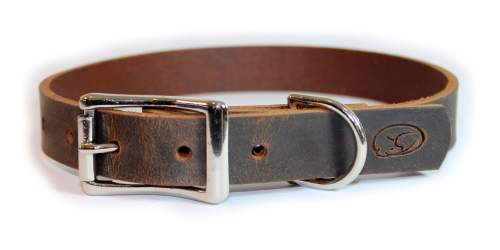
There are a lot of different materials out there used for dog collars, and we'd love to show you why a leather dog collar is a great option for your pup!
Prior to man-made materials like nylon and polyester, dog collars were made of things like leather, ropes, and chains. In fact leather collars have been around thousands of years, so they have very much stood the test of time and proven their worth.
Style
There is just something about the look and styling of leather. It's a timeless classic that looks great on any dog. Leather can be dyed a number of different colors, and be accentuated with edge paint, stamping names, animals, symbols and more onto it, and you can add spikes, crystals, conchos and more to make a one of a kind leather collar. Most leather collars use metal buckles and hardware, such as stainless steel or brass.
Cannot say enough about the quality and level of customer service. This is by far the most durable leather collar I've ever purchased--- ridgeback tested & approved!
-Sarah
There are a variety of man-made plastic materials being used for dog collars, such as nylon, polyester, and pvc. These come in a variety of colors, and many have patterns, prints, animals, logos, phrases and more printed directly onto the webbing, or onto a ribbon that's sewn onto the webbing. These are a great way to personalize your dog's look with something a little less formal than the classic leather look.
Performance
With a little love, a leather dog collar can last a lifetime and still look great. We use thick, durable, tight-grained leather for our collars, which means less stretching out when wet and a longer lifespan. All our leather is tannery-dyed, meaning the color will not bleed or run even when exposed to water. Some lower quality leather and leather that is dyed after tanning may experience bleeding or a lot of stretching when wet. We do recommend taking leather collars off of your dog and letting them dry out completely after water exposure. You can find more care and cleaning tips on our blog. Leather collars, being a natural product, are not as chew-proof as their plastic counterparts, and a dog may be able to chew through a leather collar if they have a bit of time on their paws.
Plastic collars such as nylon with plastic buckles require less maintenance if your dog is in the water a lot. If so we recommend our waterproof line of collars and leashes. Plastic collars can fade over time with UV exposure, so your bright, colorful, fun print collar may need replacing after a year or two if your dog is outside a lot. UV rays can also weaken the webbing used in the collar over time, and the webbing itself can fray with use. Plastic collars are more chew-resistant than leather, although a persistent dog may still be able to get through one.
Comfort
When fitted correctly, leather and plastic collars will be comfortable for most dogs. Over time, our leather collars may become a little softer, similar to a baseball glove that gets worn in. Some dogs experience allergic or skin reactions to nylon and man-made collars, while others experience reactions to leather or various metal hardware.
Cost
High quality leather collars like ours likely cost a bit more than traditional plastic collars. Additionally, leather conditioners are a few dollars and are found in most grocery stores and big box stores. One tin of conditioner should last a year or two.
Plastic collars such as nylon are normally $10-$40 less than high quality leather collars. However, a leather collar may outlast two or three or more nylon collars.
Conclusion
In the end, leather and plastic collars are both great choices. Figure out where your dog likes to play (or work), who they are around, how they act, and what you'd like to see on your dog when you're out and about with your pup. We're still a little partial to leather.

